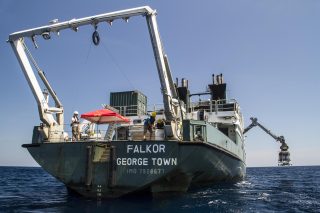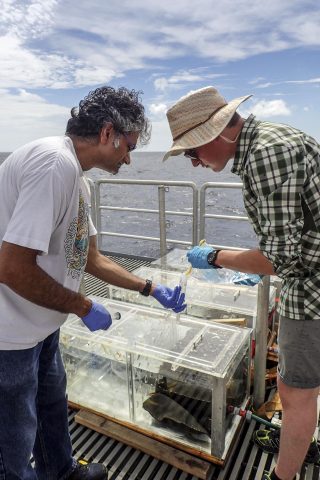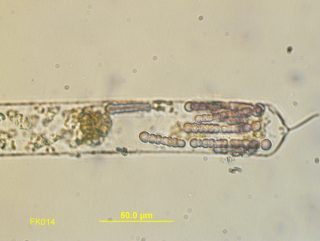
Andreas Novotny thought he would find Hemiaulus here. He has not. “It is what it is, which is fine,” he says. “What we need to do is figure out why.” Andreas is a PhD. student and his research focuses in the symbiotic relationship between a kind of plankton, a Diatom called Rhizosolenia, and a Nitrogen-fixing Cyanobacteria, called Richelia.
This kind of symbiosis is called Diatom Diazotroph Association, or DDA. There are three types of DDA, depending on how integrated the Cyanobacteria and the Diatom are. Andreas is interested in the acutest of them: Hemiaulus, when the cyanobacteria actually lives inside of the Diatom’s membrane and has lost its capacity to live outside of it.
Enslaved

In a symbiotic relationship, both the organisms living together benefit. In DDAs, the Diatom gets something very valuable: Nitrogen. Nitrogen is the most limiting nutrient in the ocean, which means it is determinant for the growth and very existence of many organisms. Since Cyanobacteria can fix Nitrogen (which means they can take Nitrogen from the air and convert it into something other organisms can feed off), Rhizosolenia is basically set with its own food court.
Things are a little more intense for Richelia. Andreas’s lab back in Sweden has found that Cyanobacteria living in a Hemiaulus symbiotic relationship has half the amount of genetic information compared to those that exist alone or in less-integrated symbiotic relationships. This means is that Richelia can no longer exist independently, and has lost part of its own genome.
Why Richelia would “choose” to make that sacrifice is one of the mysteries that interests Andreas. Fixing Nitrogen is a very energy-consuming task, and the Cyanobacteria might be getting Carbon (energy) from the Diatom. It has lost a great deal, but Andreas thinks the Cyanobacteria may have actually devised a very successful strategy – indeed, Richelia is everywhere.
Andreas wants to find out the way Rhizosolenia and Richelia communicate, if they do at all. To test this, he uses the organism’s DNA and RNA as a control panel. He can turn different switches on or off, watching how the organisms respond. If they react the same way, this would prove they affect each other – that result in itself would be a form of communication.
Nowhere in Sight
In recent days the scientific party on R/V Falkor had been collecting samples close to the Mekong River’s mouth. Today, they do so further away from the coast; still within the river’s plume but at a location where the runoff has mixed with seawater and many of the nutrients that the fresh water originally carried have been lost. Nitrogen is one of those nutrients.

Where there is less dissolved Nitrogen, Nitrogen-fixing organisms thrive because they are the only ones capable of extracting it from the air. As expected, the water samples come back filled with Diazotrophs (Nitrogen-fixers). The microscope shows more life than planktonists Lam Nguyen-Ngoc and Hai Doan-Nhu know what to do with. There is even a Diatom with six different Richelia living inside of it.
The kinds of DDAs the team has found are likely to yield key information to understand the reasons the different symbiosis behave like they do, as well as what controls their distribution and abundance.
After the cruise, once Andreas is back ashore and has traced all of these organisms’ genomes, he will be able to look back at where the sample was taken and will hopefully be one step closer to understanding the different environmental factors that encourage the very unique Hemiaulus relationship.
Still, not a single Hemiaulus symbiotic relationship has come up. Andreas is very practical: “This can only mean one of two things: either we have not found it, or there are no Hemiaulus to be found.” Andreas understands this “it is what it is” and brings researchers another step in the right direction to continue solving the South China Sea puzzle.

